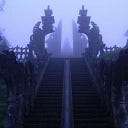Gunungan: the Javanese Cosmic Mountain

The Gunungan (from gunung = ‘mountain’), also called Kayonan (from kayon = ‘forest’) represents both the Cosmic Mountain (Mount Meru) and the Javanese Tree of Life (Pohon Kahuripan, or Kalpavriksha), the trunk of which forms a passageway between the seen and the unseen worlds (sekala and niskala). It is a symbol of spiritual realization in Javanese culture.
The Cosmic Mountain
In Java, these two fundamental spiritual concepts of the Cosmic Mountain and of the Tree of Life have uniquely merged into the Gunungan symbol, which is perhaps the most recognizable symbol of Javanese culture.
In the Javanese worldview, the Gunungan symbolizes the Cosmos, the beginning and the end of everything.
In the Javanese creation myths, the Universe begins with three beings that emerge from the Cosmic Egg (Hiranyagarbha) and immediately see the Cosmic Mountain. This is a very old myth that recurs in all Asian cultures.

Since the most ancient times, the idea of regulation of the world from a mountain has been almost universal. The Cosmic Mountain symbolizes the Universe and has been in existence since before time began. It represents both the seen and the unseen worlds (sekala and niskala).
The Javanese belief in the Cosmic Mountain and the Tree of Life was congruent with Hindu cosmology even before the formal arrival of Hinduism in Java. The Javanese Cosmic Mountain therefore naturally merged with Mount Meru, and the Javanese Tree of Life with the Kalpavriksha.

The Cosmic Mountain and the World Tree merged in a single symbol (relief on Prambanan temple)
Structure of the Gunungan
The Gunungan is either shaped like a mountain, or like a rounded tree-like ellipse, as in the case of Balinese Kayonan. A covered entrance gate generally appears at the center of a Javanese Gunungan.
There are variations in the depiction of objects within the Gunungan. Sometimes animals are depicted within the branches of the trees, like a tiger and a Banteng in fighting stance, or monkeys or birds.

The head of Kala, a monstrous personification of Time, appears on top of the entrance gate. Beyond the entrance gate, a tree grows upward along the central axis, its branches spread across and fills up the Gunungan with fine foliage motifs.
In the Balinese Kayonan, animals are seldom depicted. Instead, mythological figures like Garuda, Naga or Yaksha are depicted to represent the three-world division concept of Indonesian Hinduism.

Guardians stands on both sides of the stronghold. Their task is to guard Mount Meru (the Cosmic Mountain), and the elixir of life.
A pair of huge wings flank the upper half. The shape of these wings may be derived from lotus leaves or other types of vegetation. The gate building with closed doors is understood as female, whereas the tree represents the male. Together and united, they form life.
The temple on the Gunungan is usually guarded by Rakashas (forest spirits). Two Makaras, or masculine extensions of Kala, guarantee that nobody will enter the temple without giving up his ego. Left and right of Kala, a water buffalo and a tiger represent the unity of opposites. This iconography goes back to very ancient times.
Once accepted, the initiate enters heaven, symbolized by the Tree of Life, and reaches the pinnacle of consciousness. The demon Kala is surrounded by a halo of flames. His presence represents the annihilating forces that exist in the Universe.

The Gunungan is the symbol of Kejawen
A Synthesis of Javanese Spirituality
Within the symbolism of Gunungan are represented all the key Javanese values. The Javanese, like all Asian cultures, held that all living things had a life energy or soul, which was the same for all, but stronger in some things than in others, and that many natural objects also possessed a life force or energy.
All manifestations of nature are seen as the work of unseen forces that need to be avoided and appeased with offerings.
The Javanese tumpal motif in art, or the tumpeng of rice at slametans, or the roof of the joglo houses, or the Gunungan puppet in the Wayang theater are all symbolic of the Cosmic Mountain.

For 1500 years of Hindu-Buddhist civilization in Java, the Gunungan with its upwards-pointing triangle was understood as a symbol of Siwa (Shiva). The upwards-pointing, triangular form of the Gunungan mirrors the trident of Shiva, and Mount Meru is itself a symbol of Shiva.
The keris buda blade with its sogokan form is also a representation of the triadic nature of Shiva.
Hindu metaphysics therefore did not impose any new ideas in Java, but simply standardized pan-Asian spiritual systems that were known since times immemorial.

Javanese house with Semar and Loro Blonyo. The Javanese roofs are also a representation of the Gunungan.
A high philosophical doctrine
The Gunungan in Wayang puppet theater contains highly valuable spiritual lessons. The Gunungan represents the five elements of nature, namely earth, water, fire, wind and space. All things in nature is a combination of the five elements.
When the Wayang show starts, one sees only a white screen with the Gunungan in the middle. After the Gunungan has appeared, the five elements of nature form, and begin the story of life in the Universe.
In Javanese culture, prayers are not only uttered with the mouth alone, but are helped to manifest through the form of a cone, as an offering and symbol of one’s determination. The Gunungan in Wayang Kulit is used to symbolize human life, which evolves in a conical way until the final merger with God (Shiva).

